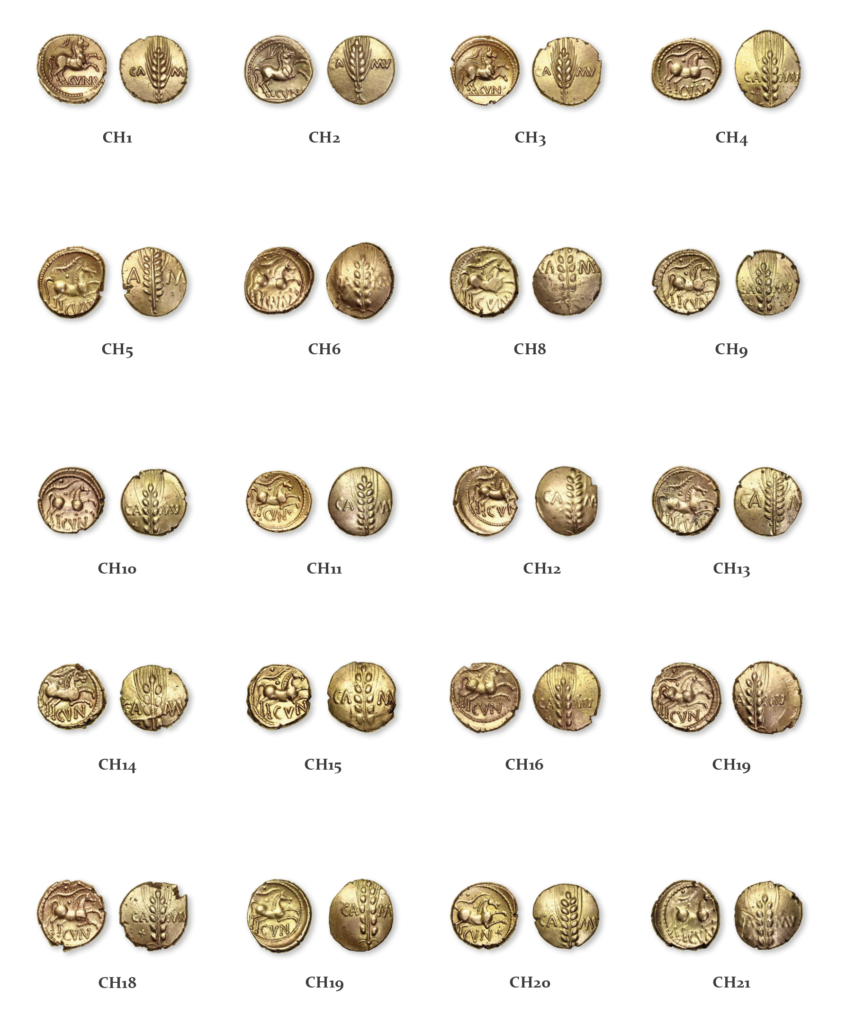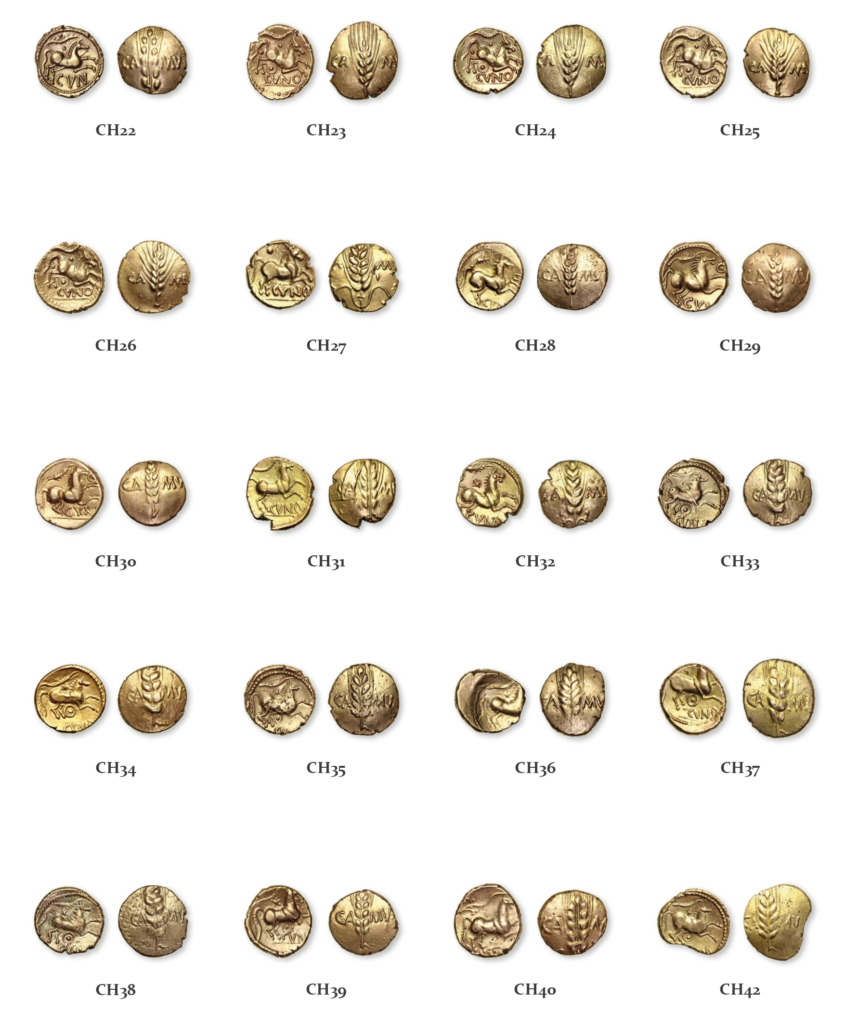This story begins on the 1st of January 1873 with the chance finding of three ancient gold coins in Kent, England.
Robertson 2000, 8-9 no. 35: “Near the boundary of the parish of Borden, while digging ground for a garden, “Mr. Prentis’ men discovered three gold coins. At first two were found together, one being Roman, and bearing the profile of Claudius Caesar, the other being a British coin of Cunobelin. The second discovery brought to light only one coin; another Cunobelin, but of a type which has never before been engraved.”
There was comment at the time and since that there may be more coins associated with the above find, a statement which, in 2018 drew great interest from an avid metal detectorist who came across this information while researching sites of potential interest. They contacted the landowner who kindly gave permission for them to search their farm for the site of this tantalising earlier find.
Many hours of searching followed with interesting finds but nothing in the way of ancient gold coins. Working around arable crop meant only very limited windows for searching, something which all metal detectorists will know well.
February 2019 came, field conditions were optimal and the search was on. A single gold stater of Cunobelin was discovered in the area described; could this be a part of the lost treasure? No further coins could be located although it was noted that the soil was particularly deep on this field, perhaps the coins were out of reach of metal detectors, which rarely detect below 12 inches. On mentioning this to the landowner it was suggested that an excavator be used to remove sections of the top soil and this led to more coins being discovered. A further 41 gold staters of Cunobelin were found, bringing the Hoard total to 42 coins.
The find was reported under the Treasure Act (1996) and deposited at the British Museum for further study. After the find being declared treasure, it was disclaimed and returned to the finder as no museum wished to acquire them.
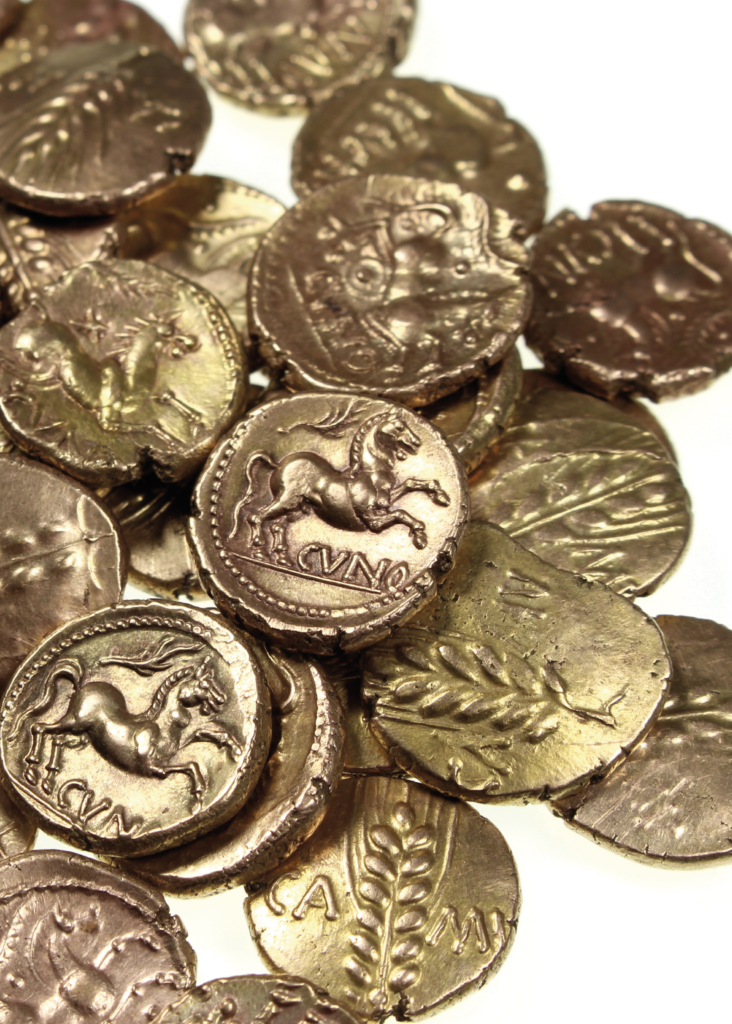
All 42 coins are inscribed staters of king Cunobelin of the North Thames coin producing region, traditionally associated with the tribes referred to as the Catuvellauni and Trinovantes.
This may be surprising given the find site in Kent well south of the Thames but coins of Cunobelin are often found in this area suggesting that for some time at least this was a part of the Catuvellauni & Trinovantes territory. All coins can be dated to the period AD 8-41 and are inscribed on one side with ‘CVN’ or ‘CVNO’ below a horse. This is an abbreviated version of the name Cunobelin. The other side shows the letters ‘CA MV’ besides an ear of corn. These letters are thought to represent the mint of Camulodunum (modern day Colchester).
Six different coin types are represented within the 42 coins, with some variations such as privy marks within each type. Examples of these six types can be seen to the below.
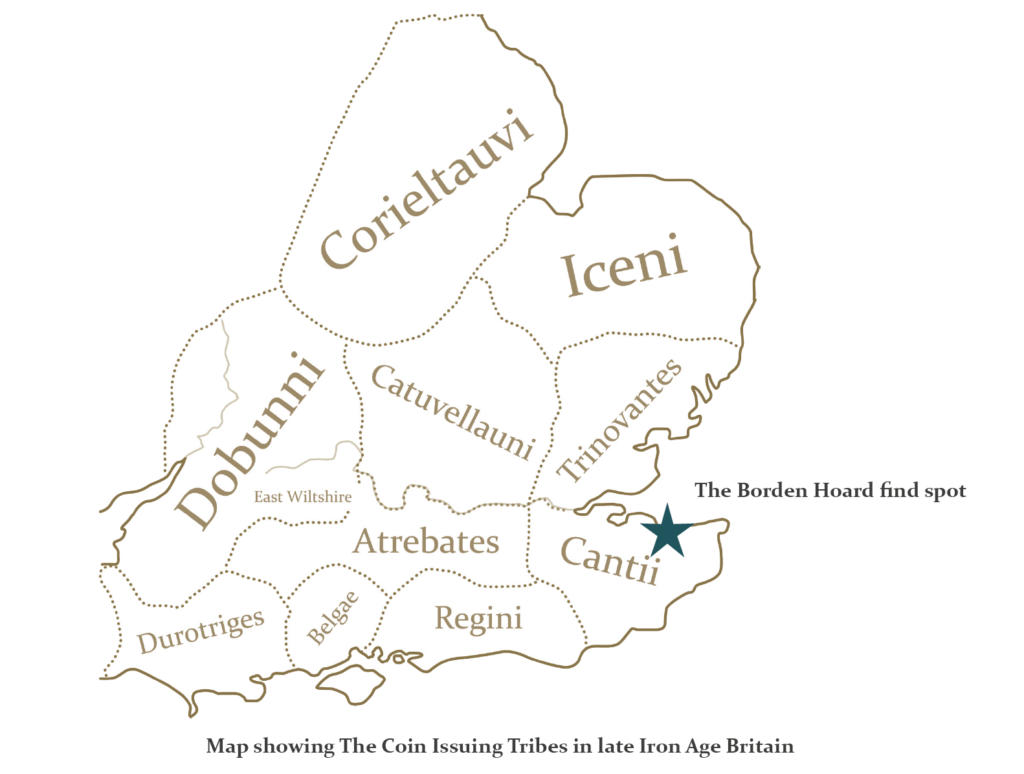
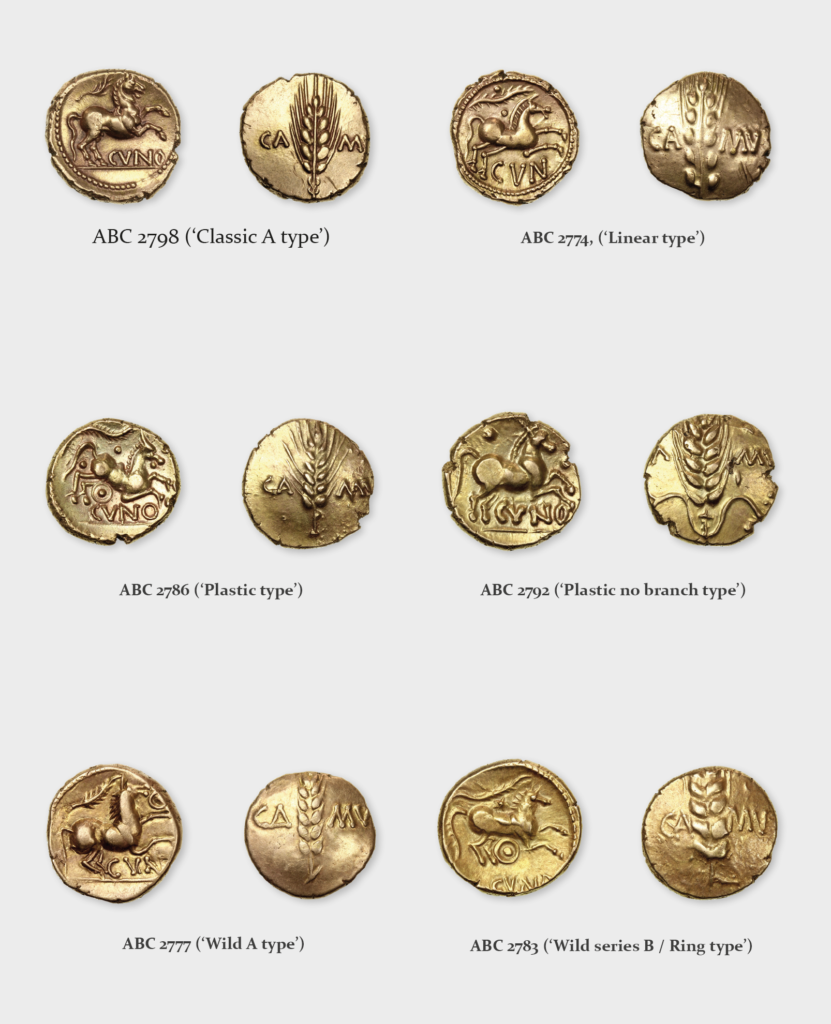
Background
The Late Iron Age in Britain (c. 100 BC onwards) was a time of great change and social upheaval; particularly the years after Julius Caesar’s two expeditions in 55 and 54 BC respectively. His brutal and destructive invasions of Gaul and incursions into Britain had the effect of pushing the Roman world into direct contact with, what were at that point, wholly different societies. Britain was irreversibly transformed as a result, its ‘prehistoric’ culture progressively influenced and ultimately largely replaced by increased contact with the world of Roman art, architecture and literature.
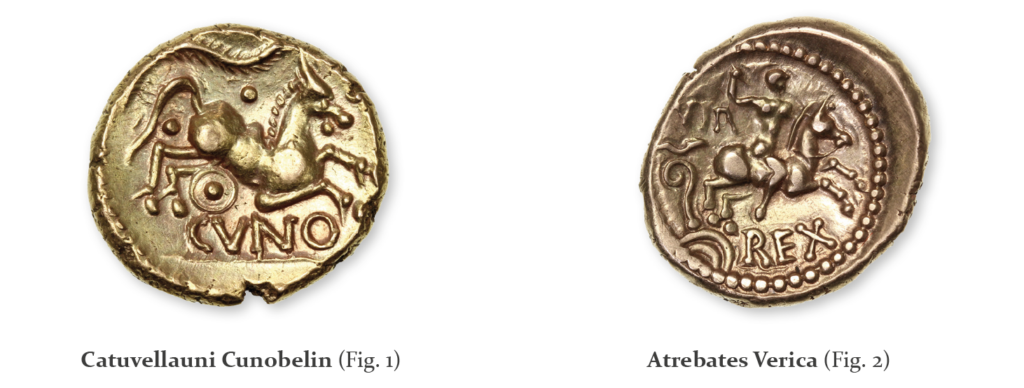
The days of comparatively disconnected farming communities, spontaneous warfare and hillfort construction that had characterised the Middle Iron Age (c. 400-100 BC) were gone. In their place we see the emergence of fortified trading centres (Oppida), evidence for movement of both peoples and material culture from northern France and changes in burial rites – products of the socalled ‘Belgic’ migration. Perhaps most importantly, the importation of diverse luxury goods originating from the Mediterranean world becomes evident. This, in particular, reflects the emergence of a more explicitly stratified society. Gold coinage began to be imported from northern France from c. 120-100 BC onwards, lasting until approximately 50 BC, while the indigenous Kentish production of sprue-cast ‘potin’ coinages began in c. 80 BC. Around or just after Caesar’s incursion, coins of gold, silver and in some regions bronze also began to be struck in Britain.
Business was obviously booming, with mechanisms of trade and exchange clearly extending both ways across the Channel. As the Greek historian Strabo wrote in c. AD 18;
‘(Britain) bears grain, cattle, gold, silver and iron. These things are accordingly exported, alongside hides, slaves and hunting dogs.’ (Strabo, ‘Geography’, book IV, chapter 5, lines 199-200).
Alongside an abundance of evidence for change in terms of the economy, infrastructure and daily lives of Iron Age Britons, the political status quo also seems to have been upturned. Caesar had, in his own writings, described exhaustively the ‘kings’ he had encountered during his battles against the Britons in Kent, listing the names of four rulers in total. However, given their number it is probably more accurate to suggest that these were in fact lesser chieftains rather than regional rulers in their own right.
As argued by the prominent Iron Age numismatist and scholar, John Creighton, the idea that Caesar’s invasions of Britain in 55 and 54 BC were failures is largely untrue. Although Caesar had not ‘conquered’ Britain militarily and turned it into a Roman province, he had instituted annual tributes, replaced the rulers of some tribes with his own ‘pro- Roman’ choices (such as Commius, a Gallic chieftain to whom he gave charge of territory in the south of England) and taken hostages – known as obsides. These were generally the sons of the British ruling classes who were taken back to Italy and educated into Roman ways – a policy which continued apace under his successor Octavian/Augustus. Such sweeping changes effectively caused a paradigm shift from the top-down in the way that Late Iron Age society in Britain operated, and in the years and decades following his invasions the rule of petty chieftains mostly vanished.
Kings, naturally aligned with Rome as a result of their foreign upbringing, began to rule on a regional basis. With sole rule comes continuity and the question of succession. As such, two key dynasties emerged in the North Thames (Fig. 1) and South Thames (Fig. 2) regions of England. Notably, both these dynasties began to issue coins from the last two decades of the 1st century BC onwards, displaying Latin inscriptions and bearing many images of purely classical origin.
We can turn again to Strabo for a summary of the situation by early 1st century AD;
‘At present…some of the chieftains there (in Britain), after procuring the friendship of Caesar Augustus by sending embassies and by paying court to him, have not only dedicated offerings in the Capitol – but have also managed to make the whole of the island virtually Roman property!’ (Strabo, ‘Geography’, book IV, lines 149-150).
The King
To Shakespeare, he was Cymbeline. For a monk called Nennius writing in the early 9th century, he was Bellinus. In Medieval Welsh oral traditions, he is Beli Mawr or Cynfelin. For the modern historian, numismatist or student of Late Iron Age Britain, he is best known as Cunobelin. Whatever he is called, he represents a very real figure whose amorphous, semi-legendary status has shifted back and forth across the line dividing myth and reality over the course of two millennia.
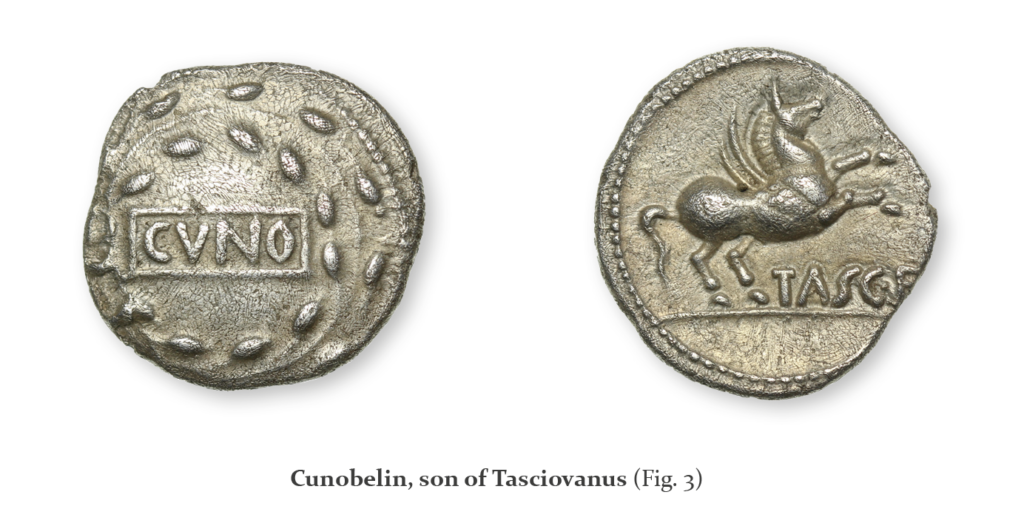
From the moment of his naming, Cunobelin (‘hound of Belenus’ or ‘bright one’) was obviously expected to accomplish great deeds. His birth-date is unknown, but we are certain that he was the son of Tasciovanos – an early ruler of the Catuvellauni. Coin evidence is key in establishing this familial relationship, as many coins struck for Cunobelin are prominently inscribed ‘CVNOBELINI TASCIOVANI F[ILIVS]’ (Cunobelin, Son of Tasciovanus) (Fig.3). He is thought to have ruled between circa AD 8 and AD 41, the use of Latin text on his coins demonstrating growing Roman influence even though Britain was not yet a Roman province.
Tasciovanos himself belonged to a Late Iron Age tribal grouping called the Catavellaunii. This loose confederation of peoples lived in and around what are now the counties of Bedfordshire and Hertfordshire. Their Oppidum was probably Verlamion, a heavily fortified site with impressive earthworks that survive to this day, sited some two kilometres away from the modern city of St Albans. The infamous instigator of resistance against Julius Caesar, Cassivellaunos, who himself was possibly also a relative of Tasciovanos, may have been one of their earlier rulers.
Like many of the other peoples that inhabited Britain in the Late Iron Age, Catavellaunian society was composed of craftsfolk, farmers and artisans – but also warriors. After all, their very name translates broadly from Brythonic (a group of Celtic languages) as ‘those skilful in war’. Under Tasciovanos’ leadership, it was evident that they continued to live up to this name – expanding their territory eastwards into that of a neighbouring tribal confederation called Trinovantes. Taking over most of what is today Suffolk and Essex, for a time the Catavellauni also appear to have conquered the regional centre of Camulodunon – probably displacing the Trinovantian king, Addedomaros, in the process.
Expansion and conquest
Cunobelin seems to have begun to rule over the Catavellaunii in about AD 8 after the death of Tasciovanus. Writing in the early 1st century AD, the Roman historian Suetonius refers to him as ‘Brittanorum Rex’ – King of the Britons. Although this exaggerates reality, it is evident that he was viewed even by the Romans as an important figure in the region. Evidence that Cunobelin himself was in some way sponsored or supported by the Roman emperor Augustus is perhaps supported by the fact that on one of his coins, he styles himself as ‘rex’ (using the Latin word for king) – in complete contrast to his father’s usage of the Brythonic term ‘rigonos’. This seems very much to be a conscious, politically-minded choice that literate users of these coins would have recognised.
Cunobelin’s first act, as a ruler in his own right, seems to have been to finish the task begun by his father, achieving a takeover of the Trinovantian capital – Camulodunon (modern day Colchester) and their surrounding territories. Coin finds imply that this did occur (when exactly is uncertain), though it probably took several years. Many of Cunobelin’s earlier bronze and silver coins, which often name him alongside his father, cluster primarily in the historic central-southern ‘home’ territories of the Catavellaunii. By contrast, his later gold coinages inscribed CAMV[LODVNON] have a much wider distribution which also extends further eastwards into Suffolk, Essex and parts of Kent.
Some have suggested Cunobelin’s slow but inexorable process of ‘annexation’ started shortly after his reign began, taking advantage of the Roman military disaster in AD 9 at the Teutoburgerwald. In this engagement, the 17th, 18th and 19th legions (totalling some 20,000 men, plus camp followers, staff officers and logistical support) were systematically destroyed in a week-long running engagement after being ambushed by the Germanic tribes. This cataclysmic event not only deprived the Romans of manpower in northwestern Europe, but also diverted their attention from Britain. Although the Roman state generally took a poor view of conflict between neighbouring client-kings under their sponsorship, it would have been difficult to enforce this in the aftermath of such a catastrophic military defeat and Rome’s pressing need to reinforce the Rhine borders.
Cunobelin, Epaticcus and the Atrebates
Any expectation that Cunobelin would be content with annexing the territory of his immediate neighbours, would prove to be incorrect. It appears that from around AD 20 onwards some degree of friction began to occur between the Northern and Southern dynasties – the latter being the second major tribal confederation of Late Iron Age Britain – the Atrebates. Ruled over by their king, Verica, the heartlands of their territory consisted what is today western West Sussex, east Hampshire, Surrey, Berkshire and perhaps parts of Oxfordshire. While Cunobelin himself ruled over the heartlands of the Catavellaunii and what had been Trinovantian territory, it was his relatives who appear to have been chosen to expand into and then rule over his new outer ‘provinces’. His brother or half-brother Epatticus (who styles himself as ‘TASCI[OVANVS] F[ILIVS]’ on his impressive gold staters) (Fig. 4) was apparently selected to annex the territory of the Atrebates. Although he did not manage to conquer all their holdings, coin find distributions suggest his dominion extended over a large part of Atrebatic territory by AD 25, consisting an arc of territory running broadly from Chichester in the south to Swindon in the north. Most of his coins were probably struck at the historic regional capital of Calleva Atrebatum – a location which will be familiar to those enthusiasts for Roman archaeology in its later iteration as the post-conquest settlement of Silchester. Despite his successes, upon Epaticcus’s death, somewhere around AD 35, much of the Atrebatic territory taken by him was temporarily lost.
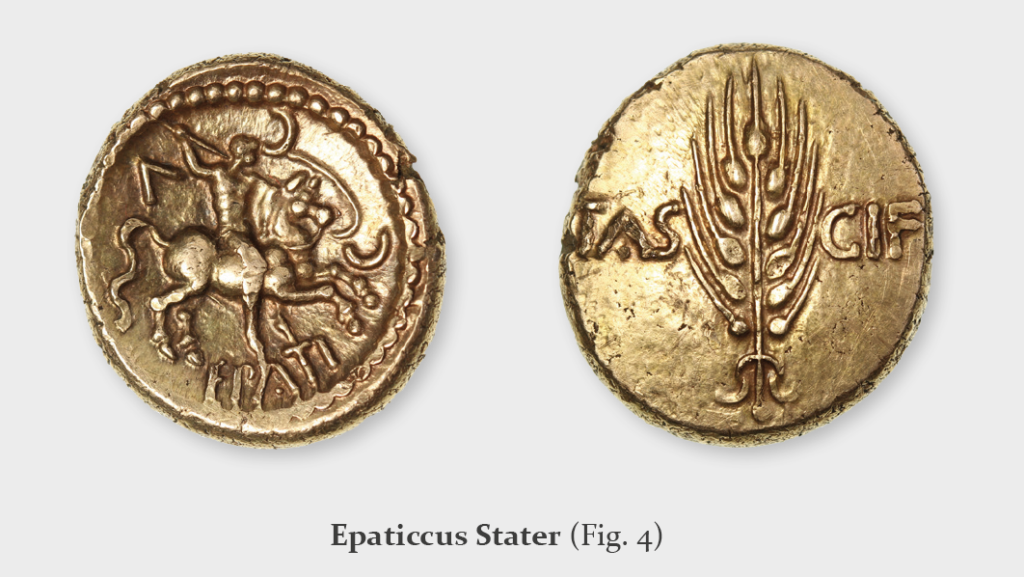
Late Iron Age Kent
The area that we now call Kent was a fertile one probably dominated by the growing of cereal crops, and the geographically closest point to the Continent. As it is today, the region was a logical entry point for new trade goods, peoples and ideas. It is one of the first places in southern Britain to demonstrate the influx of ‘Belgic’ cultural markers (as discussed in the Introduction) in the early 1st century BC. For example, the so-called Aylesford-Swarling culture – defined by the presence of cremation cemeteries and Britain’s first indigenously-made wheel-thrown pottery, is one focused mainly in Kent and the surrounding counties. When plotted, finds of Gallo-Belgic coins dating from 120-60 BC show a large clustering in Kent – indicating that this was likely the region in which they first arrived and circulated intensely. Perhaps inspired by their French cousins, the Iron Age inhabitants of the area were responsible for the first coins manufactured in Britain – the ‘flat linear’ potins copying issues from the former Greek colony of Massalia (modern day Marseilles), Fig. 5.
Writing in his personal account of the Gallic Wars (De Bello Gallico), Julius Caesar himself extolled its status as a cosmopolitan and highly developed region. When he invaded Britain in 55 and 54 BC, both his landings were sited in Kent;
‘By far the most civilised (of the British tribes) are those who dwell in Kent, which is an entirely maritime region. They differ only in small respects from the Gauls in their customs and way of life.’ Caesar, De Bello Gallico, book 5, v. 14.
When Caesar invaded Kent, he records an encounter with five ‘kings’ from Cantium who opposed him, Cassivellaunos; Cingetorix, Carvilius, Taximagulus and Segovax. Due to their number, these were probably local chieftains rather than kings. Whatever their status or titles, they never issued any coins – or at least, no coins bearing their names or an abbreviation thereof have been securely attributed to them.
Coinage certainly existed in Kent during this period, and indeed a series of distinctive gold quarter staters were struck in the area in the three decades after Caesar’s invasion. However, none of these were inscribed.
Somewhere around 20 BC, the Kentish picture changes somewhat. Coins begin to appear bearing the name ‘DUBNOVELLAUNOS’, struck in gold, silver and bronze. In terms of artistic style, many of these compare well with Trinovantian issues of Addedomaros – and thus it has been suggested that Dubnovellaunos was perhaps another ruler affiliated with this confederation. However, a key difference is in the findspots of their respective coins – whereas both Addedomaros’ and Dubnovellaunos’ coins centre on Hertfordshire, only Dubnovellaunos’ are found in comparably large numbers south of the Thames.
This observation might imply that the two were affiliated or allied in some respect, with Dubnovellaunos’ sphere of influence extending to hegemony over Kent as well as areas north of the Thames. It is also notable that in the ‘Res Gestae Divi Augusti’ (lit. trans. ‘the achievements of the deified Augustus’), a self- aggrandising document compiled by the Roman Emperor Augustus in the early years of the 1st century AD, reference is made to a ‘King Dumnobellaunos’ from Britain paying tribute to him as a suppliant – could this be the same man?
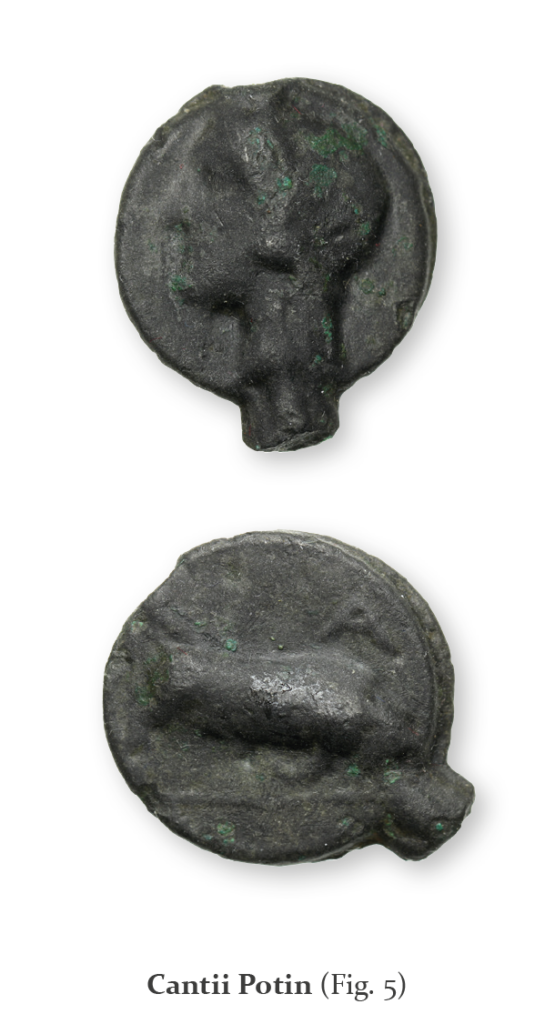
Cunobelin, ‘Amminus’ and Eppillus
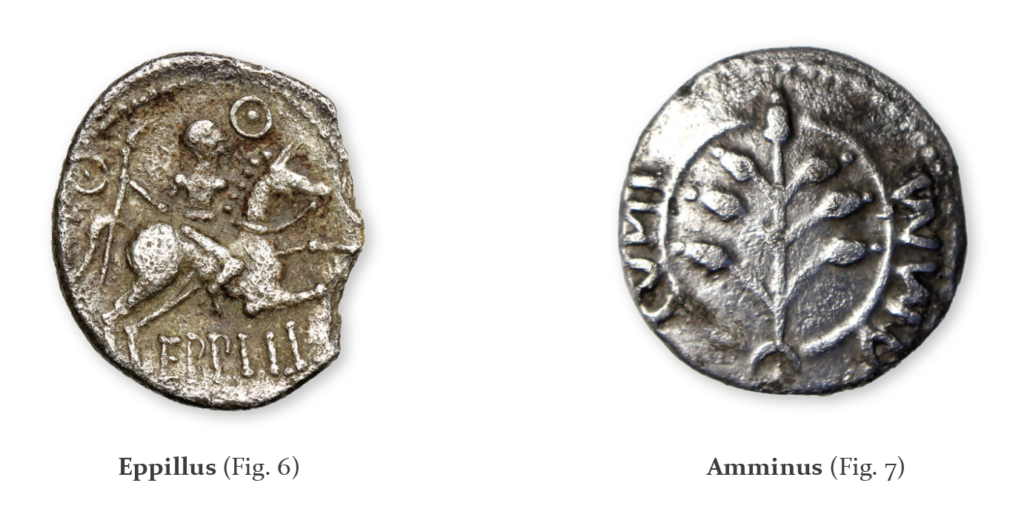
It is highly probable that the exact sequence of events which transpired in and around Kent in the first decades of the first century AD will never be fully unravelled. The dearth of first-hand historical sources and limitations of the archaeological record are often, sadly, not conducive to the formation of exact chronologies. In this case, coin find distributions do little to achieve clarity, instead portraying a highly complex and changeable picture.
It is evident that Kent appears to have been something of a contested area in the final years of the Late Iron Age. Its maritime access, trading links and fertile soils would have made it an appealing addition to the territory of any ruler. Although coin find evidence suggests that Cunobelin extended his control over the area, he is not the sole individual whose coins circulated there. It is notable that there is a heavy concentration of pieces struck in the name of the Atrebatic King Eppillus, (Fig. 6) purportedly a son of Commius – who probably ruled until around AD 15. His coins stylistically would appear to be later than those issued by Dubnovellaunos, but are probably broadly contemporary with Cunobelin’s.
An individual called Amminus (Fig. 7) (almost certainly one and the same as Cunobelin’s third son, Adminius) also issued coins in Kent with a comparable artistic style to Cunobelin. Some of these bear the inscription ‘DVRO’, which has been interpreted as a mint signature, possibly reflecting their striking at the fortified settlement of Durovernum.
This was probably the tribal capital of the Cantiaci, sited at what is now Canterbury – a precursor to the Roman town of Durovernum Cantiacorum. The similar artistic style, and fact that coins of this ‘Amminus’ and Cunobelin occur together in Iron Age coin hoards is a clue in establishing a temporal relationship between the two. Both these factors suggest that they probably were issued contemporaneously. However, it is interesting that while Cunobelin’s coins are found in Kent in large numbers, they are not really encountered at all in West Sussex, Hampshire or Berkshire; despite the fact that he supposedly had control of these areas. Although this could be partially explained by sheer distance from mint locations, one could counter that argument with the assertion that more coins of Cunobelin have been recorded from Oxfordshire than Cambridgeshire (135 against 85), the former being much further away from the main Catavellaunian mint at Camulodunon. The observation is nonetheless interesting, but the whys and wherefores of its occurrence remain challenging to interpret.
It is therefore difficult to explain the situation in Kent from the information available – though we can speculate. Was the region a battleground for the eastern and southern dynasties to settle their differences, or is it more appropriate to interpret the diverse mix of coinage from different tribal confederations as reflecting intense mercantile activity? Was the region, as some have suspected, ruled by Cunobelin and his heir Adminius – or did it perhaps retain a degree of independence? We shall probably never know the true state of affairs.
Cunobelin’s last years
In AD 41, after around 30 years of rule – Cunobelin died. Probably aged in his 60’s or 70’s, he had accomplished much during his life. A great swathe of Britain seems to have come under the control of the North Thames dynasty, benefiting greatly from its pro-Roman stance and trade with the continent. His coins circulated widely across Southern Britain, and distant emissaries from tribes such as the Corieltavi and Dobunni apparently paid him homage. Although by no means King of all the Britons, he was certainly Britain’s most powerful Iron Age ruler.
As befitting his importance, the old king would likely have been laid to rest in a prominent location, probably within a mound or barrow – surrounded by luxurious grave goods befitting his immense wealth. Despite much searching, this has never been found. Local folklore names him as the occupant of the so-called tumulus at Lexden, near Colchester – though this was seemingly only sealed somewhere between 15 and 10 BC. Containing a silver medal depicting the Roman Emperor Augustus, a table and pieces of monumental statuary in bronze amongst other high-status items, it is now considered more likely to be the grave of a Trinovantian king – perhaps somebody like Addedomaros or Dubnovellaunos.
The Coinage of Cunobelin
For many years, academics and scholars have argued about the purpose and meaning behind coinage in Iron Age Britain. Unfortunately, on the whole these are questions which in their exploration have produced few answers. It is generally mooted that the production of gold coins struck in the aftermath of Caesar’s invasion was probably produced with a view to making bullion ‘official’, promoting artistry and turning large amounts of precious metal into smaller, portable objects associated with the concept of elite gift-giving, votive deposition and some larger trade transactions.
However, by the last two decades of the 1st century BC, this had turned into the production of distinct ‘trimetallic’ denominations (gold, silver and bronze) as part of what was probably a largely monetary based economy. Despite this, religious overtones still remained – and it is indeed true that many later Iron Age coins are to be found in large numbers at shrine sites along other artefact types. Presumably, these were deposited there as dedications to the deity the shrine stood in honour to. Some were undoubtedly deposited in the Late Iron Age, whereas others seem to have been buried later – perhaps as late as the second or third century AD in some instances.
Cunobelin’s coinage is extensive, in fact – it is the broadest issued by any ruler during the British Late Iron Age. Almost 80 different types of gold staters, quarter staters, silver units, bronze units and rarer fractional pieces were struck in his name. This fact alone makes forming a comprehensive collection of his coins a worthy challenge indeed for any collector.
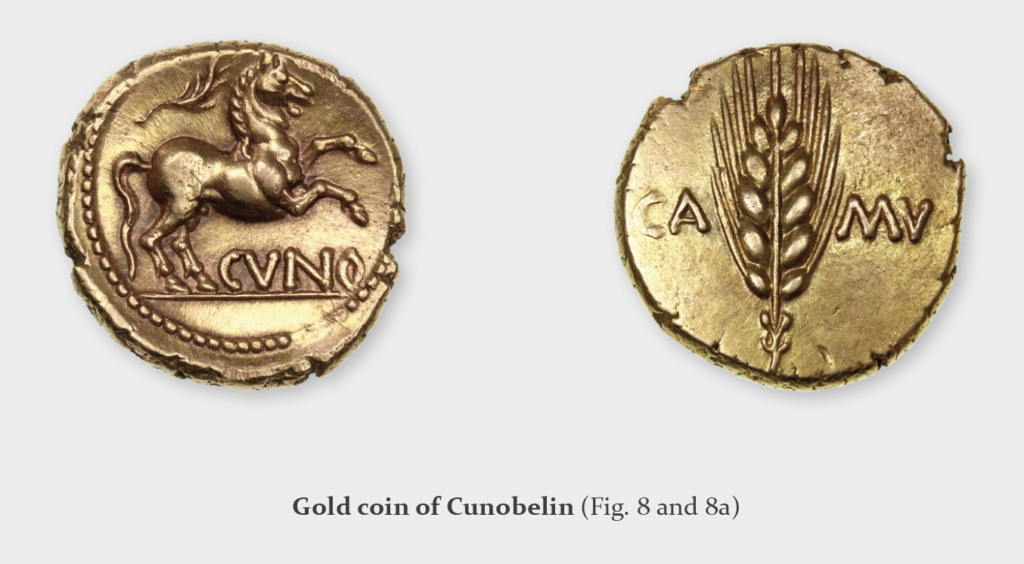
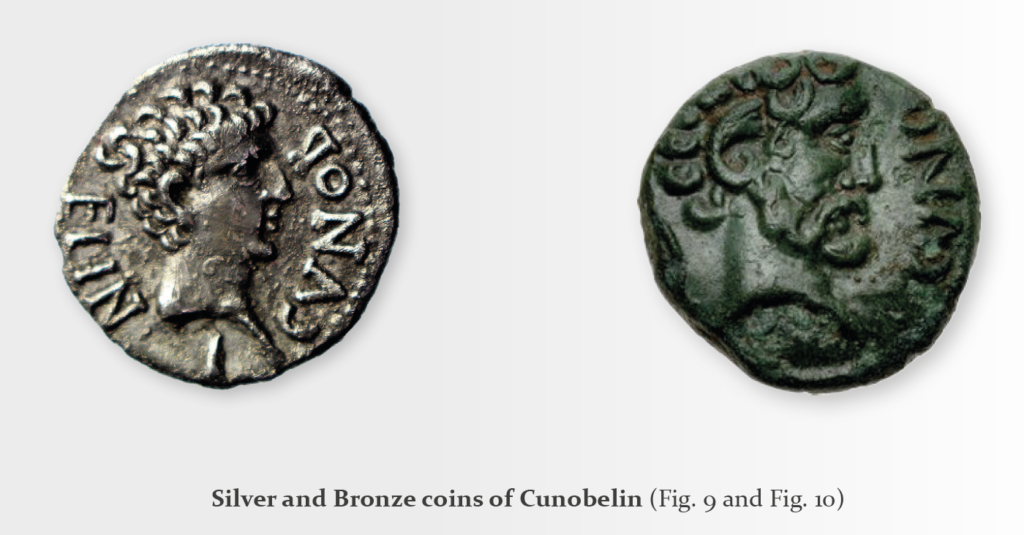
Contact with Rome had brought Iron Age die cutters into contact with coins and gemstones depicting a true menagerie of fantastical beasts from the Classical world. As such, these wholly ‘foreign’ images were replicated to varying degrees of accuracy on many of Cunobelin’s coins – but often are encountered juxtaposed alongside scenes that would have been familiar to Iron Age Britons. Sphinxes, griffons, gorgon heads, winged horses, centaurs and Roman-style busts rub shoulders with bristling boars, snarling hounds and horsemen (Fig. 11 – 14)
A BIG thank you to the finder for his hours of searching to locate this buried treasure and for his careful excavation. Thank you also to the landowner for allowing him to search the land which led to this hoard being discovered and to everyone else involved in getting this exciting find to this point.
It has been a pleasure to be involved with another amazing Treasure find, from the beginning to the end of the process it is always enjoyable and something we are very passionate about. Now it’s our turn to pass this enjoyment on to you, the collector, and give you an opportunity to own the coins from a real Iron Age Treasure find.
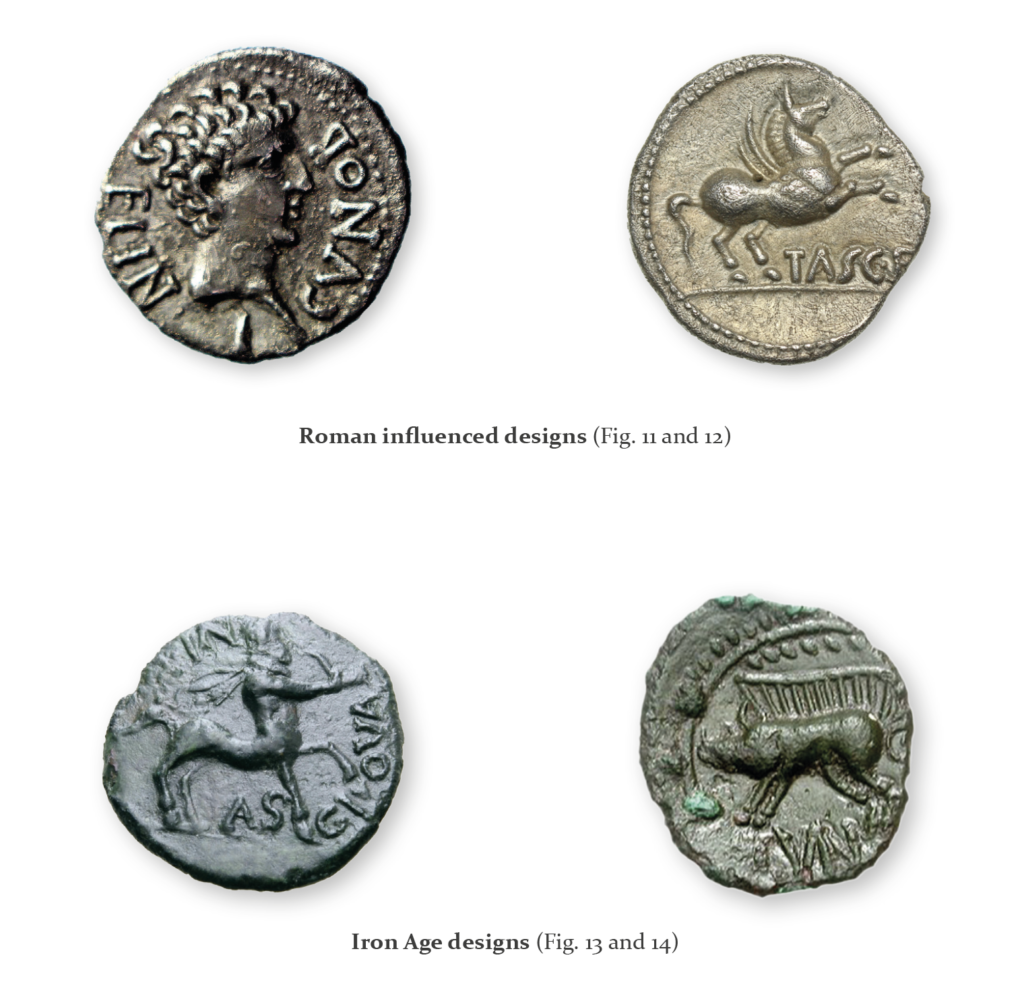
The Borden Hoard
